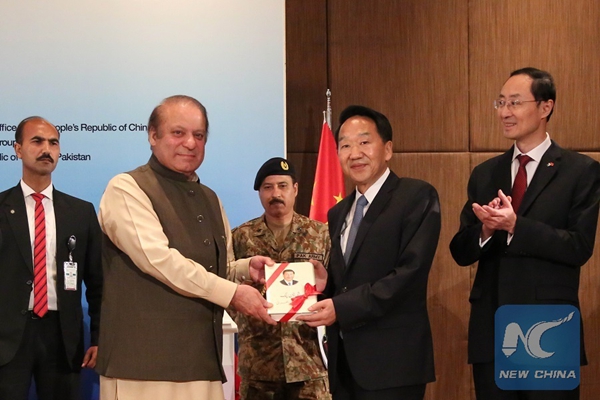
Chinese President Xi Jinping(C) inspects the Xiongan New Area scheme in Anxin County of Baoding City, north China’s Hebei Province, Feb 23, 2017. Xiongan New Area, an economic zone about 100 kilometers south of Beijing, will span Xiongxian, Rongcheng and Anxin counties in Hebei Province, covering 2,000 square kilometers in the long term with a population of 2 to 2.5 million. (Xinhua/Lan Hongguang)
Plans for Xiongan New Area, an economic zone about 100 kilometers south of Beijing, are becoming more clear.
The zone will span Xiongxian, Rongcheng and Anxin counties in Hebei Province, covering 2,000 square kilometers in the long term with a population of 2 to 2.5 million.
The surprise announcement to set up the new area on April 1 actually represented the results of years of research and rumination by the Communist Party of China (CPC) Central Committee, and is a major strategic decision which will open a new era of development in the region.
MILLENNIUM PLAN
Drawing an analogy to legendary Chinese flood control hero Dayu, who contained flooding by means of dredging rather than obstruction, President Xi Jinping said, “The capital’s core functions should be preserved and strengthened, and some inappropriate functions adjusted and weakened.”
“Some functions should be transferred to Hebei and Tianjin,” said Xi, also general secretary of the CPC Central Committee.
Addressing a central economic meeting at the end of 2014, Xi said that transferring Beijing’s non-capital functions, lowering its population density and promoting economic and social development commensurate with its population and resources must be at the core of coordinated development of the Beijing-Tianjin-Hebei region.
During CPC meetings in April 2015, Xi suggested investigating the possibility of a new city in Hebei, built according to new development concepts.
On March 24, 2016, Xi heard a report on the creation of Beijing’s “subsidiary center” and another area where non-capital functions would be shifted from Beijing. The subsidiary center is to be located in the eastern suburb of Tongzhou while the other area will be Xiongan.
Xi stressed that Beijing is at an historic juncture. Tongzhou and Xiongan will form two “wings” for Beijing and create new growth engines for Beijing-Tianjin-Hebei.
On May 27, 2016, Xiongan New Area appeared for the first time in a report reviewed at a Political Bureau meeting of the CPC Central Committee.
Calling it a “major historic and strategic decision” that would be “crucial for the millennium to come,” Xi said the subsidiary center of Beijing and Xiongan New Area should withstand the test of history, and be the legacy of this generation of CPC members.
People will see that Xiongan New Area, Pudong New Area in Shanghai and Shenzhen Special Economic Zone in Guangdong form a ladder from north to south across the map of China to act as the testbeds for the country’s reform and opening up.
These areas are expected to work together to balance the development of China and change the country’s make-up which features a strong economy in the south and weaker economic development in the north.
A NEW WING FOR BEIJING
It took some time to choose the location for an ideal new city.
Under Xi’s direct guidance, the process began in February 2015, with the final proposal deliberated and agreed by the Standing Committee of the CPC Central Committee’s Political Bureau on March 24, 2016.
Xiongan sits at the center of a triangular area with Beijing, Tianjin, and Hebei’s capital Shijiazhuang at the apexes.
With good road and rail access, Xiongan commuters will be able reach any of the three cities in about 30 minutes, The site is only 55 km from Beijing’s new airport.
The area also has a pleasant environment with a relatively low degree of urbanization. Less than 100,000 people currently live in the core area, about the same of a regular residential community in Beijing.
Visiting the location on Feb. 23 this year, Xi expressed satisfaction with the location, population and natural resources of Xiongan.
“It’s a good choice, as it will not create too much trouble for locals, involves only a small amount of relocation and something can be achieved in a short time,” said Xi.
According to the president’s plans, Xiongan New Area will primarily be the receiver of non-capital functions from Beijing, including some administrative and public institutions, company headquarters, financial institutions, higher education institutions and sci-tech units.
A NEW CITY MODEL
During his February visit, Xi called for “world vision, international standards, Chinese characteristics and high goals” in planning and construction.
If all goes according to plan, the area will have an excellent environment, optimal urban layout, great public services and innovative development.
As Xi has stressed on many occasions that eco-protection should be the priority in construction. Xiongan New Area is home to Baiyangdian, one of the largest freshwater wetlands in north China.
Urban design is another keyword. “Every inch of land should be clearly planned before any construction begins,” Xi said many times during meetings.
World renowned planners and architects from home and abroad will design Xiongan, with the area to become an exemplar of future city construction.
With a free hand to improve public services, provide better public resources and advance reforms in fields including household registration, investment, trade and city management, Xiongan will attract the very best talent.
In preparation, purchases and projects related to land and property and changes to household registration have been blocked in the three counties since June last year. Local authorities are on high alert against illegal land and housing purchases or construction to guard against speculation.
According to the plans, a major transportation network and basic infrastructure should be in place in Xiongan by 2020. The area will be well connected to Beijing, Tianjin and Hebei by 2022 when the Winter Olympic Games are held.


